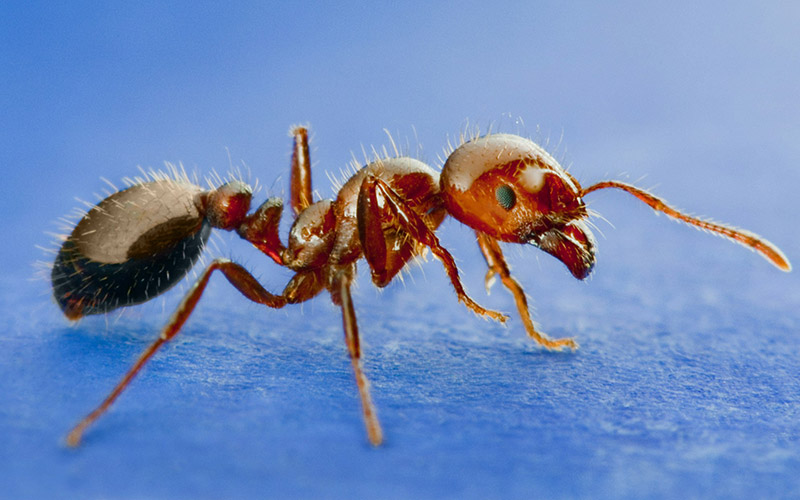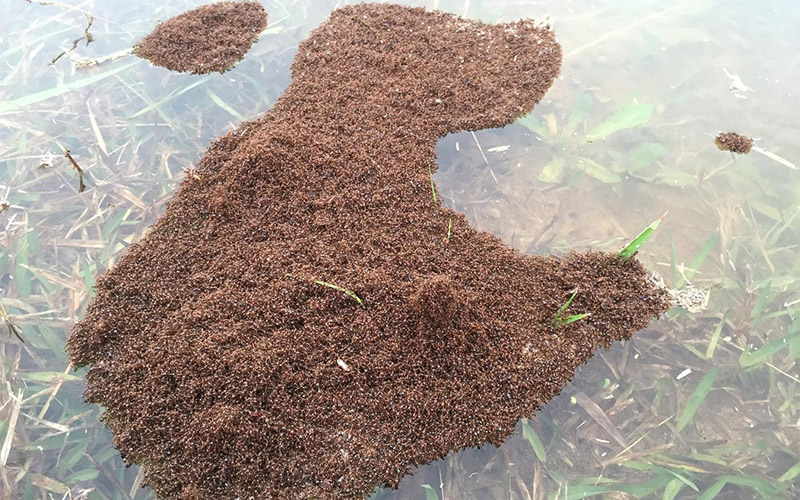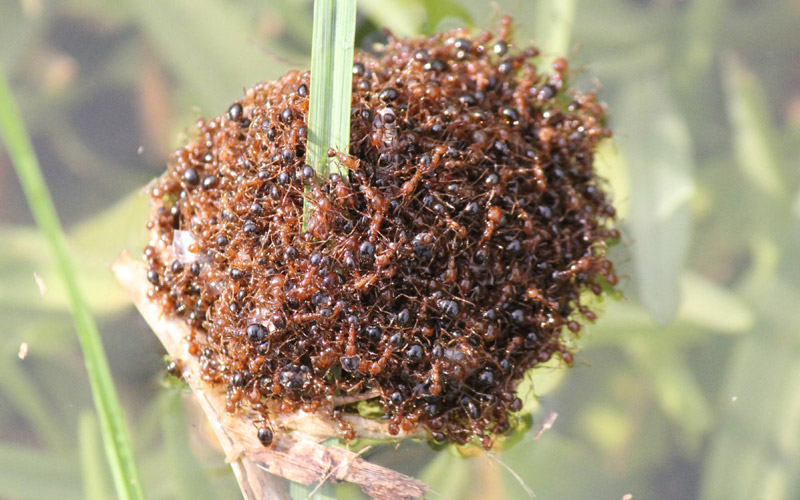Floating Imported Red Fire Ants: A Post-Hurricane Hazard in the Landscape - Sit Down with CEPRA
When hurricanes or tropical storms hit, the primary focus is often on the immediate and visible destruction-flooded homes, downed trees & limbs, palm fronds and leaf litter. Post storm cleanup is something that we all want to start as soon as possible after the storm passes. However, we need to be very cautious and aware of the possibility of potential hazards, like downed electrical lines, sub surface debris and another less obvious but equally dangerous threat lurks in the water: floating rafts of Imported Red Fire Ants. These ants are notorious for their ability to survive floodwaters by forming dense, floating masses that can spread across the landscape during and after severe weather events.

Red Imported Fire Ant (Solenopsis Invitation)

Fire Ant Mound
The Imported Fire Ant: A Formidable Invasive Species
The imported fire ant (Solenopsis invitation) is an invasive species originally from South America, introduced to the United States in the early 20th century. Since their arrival, they have spread throughout the southern U.S., thriving in warm, humid environments like Florida, Texas, and the Gulf Coast. Their presence in these regions has become a concern due to their aggressive behavior and painful stings, which pose risks to both humans, domestic animals and livestock.
Fire ants are highly adaptable, particularly when it comes to surviving environmental challenges such as flooding. After heavy rains and hurricanes, they use a unique survival strategy-rafting-to escape rising waters.
How Fire Ants Form Rafts
As the water rises, the Fire Ants get flooded out of their underground nests. The Fire Ants then band together to form floating colonies by linking their bodies together to create a raft-like structure, with such high surface tension and strong connections that they are nearly impossible to break apart. Each ant clings to others using their legs and jaws, trapping air between their bodies. This creates a floating, water-resistant layer that allows them to survive for days or even weeks on floodwater. Fire Ants have a waxy exterior that protects them from drying out in the hot temperatures of the south, but in conditions where they encounter flood waters, this waxy layer also helps expel water.

Red Imported Fire Ant Raft

Close Up: Red Imported Fire Ant Raft
At first glance, the ant ship looks like a pile of dirt or debris. At a closer inspection, the small insects can be seen swarming around each other as they fight to stay afloat.
The ants protect their queen by placing her and the brood (eggs, larvae, and pupae) at the center of the raft, ensuring the survival of the next generation. These rafts can consist of thousands of ants, floating through floodwaters in search of higher ground. Keep in mind that higher ground can be anything that is dry: a tree, a dead palm frond, a debris pile, or your leg. As floodwaters recede or the ants encounter a dry object, they will start to offload their members where they can rebuild their colony.
When heading outside to start your post-storm clean up, make sure you wear work gloves, boots or close toe shoes, long sleeves and pants. Be on the lookout for floating brownish-red areas that look like small particles of debris or mulch. More than likely, these are Imported Red Fire Ant rafts.
What NOT TO DO if you encounter a floating Red Imported Fire Ant raft:
- DO NOT try to force the colony down into the water to drown them. They will not sink, but they will go into attack mode.
- DO NOT try to scoop them up with a pool net or any other object.
- DO NOT try to toss water on the raft, as this will only scatter some of the raft, provoking the ants to turn on the "attacker."
The Impact on the Post-Hurricane Landscape
In the aftermath of a hurricane, floating Fire Ant rafts pose several threats to both people, domestic animals, livestock and to structures:
- Increased Risk of Stings: Encountering a Fire Ant raft can be hazardous. If disturbed, the ants may swarm and sting aggressively, injecting venom that can cause painful welts and, in some cases, severe allergic reactions (prophylaxis). For those wading through floodwaters or attempting to clean up debris, the risk of stepping into or accidentally disturbing a raft is high. Fire Ants can latch onto exposed skin quickly, making them particularly dangerous in flooded areas where visibility is limited.
- Invasion of Homes and Structures: Red Fire Ant colonies displaced by flooding often seek refuge in higher ground, which can include homes, buildings, and other structures. After a hurricane, it's common to find Fire Ant colonies nesting in electrical equipment, insulation, and other hard-to-reach areas. Be particularly cautious around electrical equipment, as ants can damage wiring and circuits while nesting in these areas. This invasion can lead to further property damage and create additional challenges during the already difficult process of post-hurricane recovery.
- Monitor Pets and Livestock: Fire Ants are not only a danger to humans but also to pets and livestock. After flooding, check areas where animals sleep or roam for signs of ant activity and keep them away from floodwaters where ant rafts might be present.
Long-Term Management of Fire Ants
While floating Fire Ant rafts are a direct consequence of flooding brought on by a severe weather event, the broader issue of fire ant management in storm-prone areas requires ongoing attention. Integrated pest management (IPM) strategies, systemic insecticide applications, baiting, and biological control, can help reduce fire ant populations over time. However, due to the ants' resilience and aggressive nature, complete eradication is extremely challenging.
Conclusion
Floating Imported Fire Ant rafts are an often-overlooked threat in the aftermath of hurricanes and flooding. As resilient invaders, these ants are known to be tough and hardy, but the fact that they can float during periods of flooding or heavy rains often surprises people. Understanding this special survival instinct can help you prepare for a fire ant invasion after the next big storm. By staying vigilant and implementing proper safety measures, we can better protect ourselves from the hazards associated with these tenacious insects in a storm's wake.
